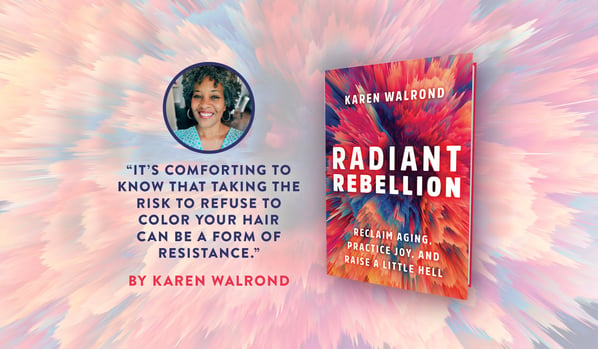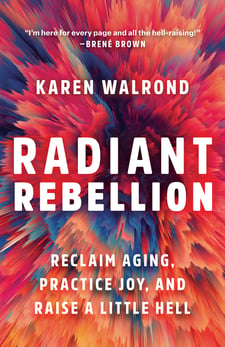It turns out that the phenomenon of dyeing hair is a relatively new one. In the early part of the twentieth century, only about 4 to 7 percent of American women colored their hair—that is, until beauty companies figured out that there was a killing to be made by tapping into women’s anxiety around aging. And they weren’t even subtle how they went about it: one 1943 Clairol ad called gray hair “The Heartless Dictator,” stating, “Without justice or kindness, gray hair can rule your life. . . . It can dictate many things you say or do. No wonder other women refuse to tolerate this tyrant.” The aggressive marketing worked: Nowadays more than 70 percent of women in America dye their hair. It’s practically a national pastime.
The thing is, we often dye our hair without so much as a second thought. In her book Going Gray, journalist Anne Kreamer documented her path to silver. As part of her experiment, she gathered fifteen girlfriends ranging in age from their mid-thirties to their mid-sixties to hear their thoughts about going gray. As the women began sharing why they chose to either continue dyeing their hair or stop coloring altogether, it became clear that, until that conversation, they hadn’t really examined their reasons for making the decisions about their hair color. “It was as if a lightbulb went off over everyone’s head,” she writes. “We sort of know on a subliminal level that most of us are faking it—these days a majority of American women over forty dye their hair—but we seldom actually let ourselves think about this and what it implies.”
And so, as I stood there with my hair dripping with dye, staring at myself in the mirror, I considered what coloring my hair implied in my own life. Hadn’t I experienced a similar reckoning with the reasons I’d straightened my hair in the past? Were my reasons for dyeing my hair in any way like the reasons I used to justify minimizing my lips or narrowing my nose? Was I coloring my hair because I loved the color I was adding, or was I doing it to hide the color I was becoming? And if it was for hiding: What did that mean, exactly?
Ultimately, I decided there was only one way to find out: I finished applying the dye, and while waiting for it to take effect, I made an appointment at my hair salon for two months down the road. On the day of my appointment, I walked in and then walked out with a brand-new haircut: back to the cropped look I sported when I stopped chemically straightening my hair, only about half an inch long, completely dye-free. It was only hair, after all: I’d worn it short several times over the years, and I knew I could grow it back and dye it again if I changed my mind. But for the purposes of my own self-interrogation, I wanted to experience what it felt like to move through life without any attempt to look younger than my age.
If this sounds brave, let me clarify: I was terrified. I had become quite comfortable—some might say prideful—being told that I looked almost a decade younger than I was. My new cropped haircut was decidedly “salt-and-pepper,” and while it was still more pep-per than salt, I worried that folks would think I’d “let myself go.” What if people now thought that I was a decade older than I was? And if they did, how would that affect me?
My mother had an immediate reaction. “You cut your hair! You know I always love you with your hair short.”
“Thanks, Mom.”
“And . . . wow. Wow. Look how gray you’ve gotten!” “Yup. I guess that’s what a hurricane and a pandemic will do,” I said.
“So you’re not dyeing it anymore?” My mother, now in her eighties, had her own gorgeous, silvery-white hair.
“I don’t think so.”
“Well, you get your gray hair from me.” It was true: my father, also in his eighties, only had a smattering of white in his own hair, almost less than I did. “But I didn’t stop dyeing until I was much older than you. Why are you stopping now?”
“I dunno. It’s just time, I guess.”
She furrowed her brow, and a look of concern spread across her face. “Well, what does Marcus think?”
For the record, my husband and daughter had barely batted an eye. Marcus was already quite silver and had always preferred my hair short, so he loved the cut. Alex, now sixteen, looked at me without any expression: “Oh, you’ve cut your hair again,” she had observed, before returning to her phone.
“Honestly, I don’t think I care what he thinks, Mom. It’s my hair!”
“Well, I suppose that’s true,” she conceded. “It’s a different time . . .” As her voice trailed off, I took the opportunity to change the subject.
While I acclimated to my new look, I began searching for folks my age who allowed their hair to go natural. To my surprise, there were very few. One of them was my client and friend Amy, who has a beautiful mane of snowy white hair.
“I’m so excited for you that you’re letting your hair go silver!” she said one day.
“Thanks,” I said. “I so love yours. Did you just let your hair naturally go silver over time, or did you used to dye it?”
“Oh, I used to dye it,” she said. “But eventually, I was doing it so often, I just gave up.”
“Same. Any regrets?”
“None,” she grinned. “I love it. I love it. I get complimented on it every day. Best decision I ever made.”
As time passed, people began noticing my hair growing more and more white. One day, I caught up with Mike, the friend I made in Africa. “Can I just say,” he said, “I love that your hair is going silver.”
“Thank you,” I smiled.
“Honestly, I just think gray hair is amazing. I used to beg my wife, Caroline, to stop dyeing her hair, and she finally stopped because it was such a process. It’s fantastic! She gets complimented all the time. I love it.” “Well, I really appreciate you saying this. It’s an experiment, but it’s definitely growing on me.”
It’s now been just over a year since I’ve stopped dyeing my hair. I’ve also begun growing it out again, and at this point it has about as much salt in it as pepper. And like Mike’s wife, it’s a rare day that I go out in public and a stranger doesn’t comment approvingly. On a recent holiday in the Caribbean, the groundskeeper of our hotel shouted to me as I walked past: “Sistah! Ah lovin’ de hair, man. Ah does keep tellin’ meh own sistah she mus’ leh she hair go white-white-white. It does make yuh look like a queen!”
While other people’s opinions of my hair shouldn’t matter, I admit it’s encouraging to receive such an overwhelmingly positive reaction. But I have a theory about why folks react with such admiration, and I don’t think it has that much to do with my hair. I think the real reason that people react so positively is that I’m comfortable with having silver hair. In a world where everyone dyes their hair, my silver is something of a novelty. It’s almost as if I’d dyed it blue or pink. Because women are expected to hate going gray and fight it every step of the way, folks are intrigued with any woman who is actually okay with the way her hair is shot through with white.
As evidence, I offer journalist Anne Kreamer’s words, these about one of the main characters in the blockbuster movie The Devil Wears Prada. Kreamer writes: “Meryl Streep played an absolutely ungrandmotherly white-haired magazine editor, the personification of stylish glamour. Almost every review made a point of mentioning her hair color, and in the movie narrative, her public alpha-female self-confidence is reinforced by her tacit refusal to submit to the blend-in-with-the pack camouflage of artificial hair color. According to Entertainment Weekly, Streep chose the striking ‘Cruella De Vil’ look herself, saying, ‘In a business that’s all about artifice, I like the pride of having naturally beautiful white hair and not coloring it.’”
In a world where you can be penalized for allowing your hair to go silver, the instinct to dye is an inarguably reasonable one. But it’s comforting to know that taking the risk to refuse to color your hair can be a form of resistance. And maybe, on the best of days, it can even be sexy.
This is an excerpt from Radiant Rebellion, chapter 5: “Beauty Myth.”




